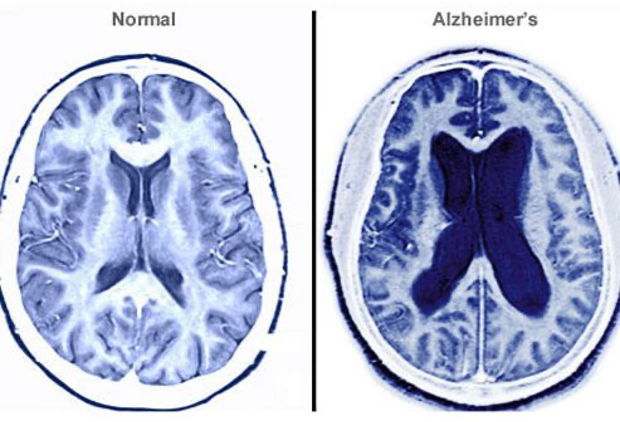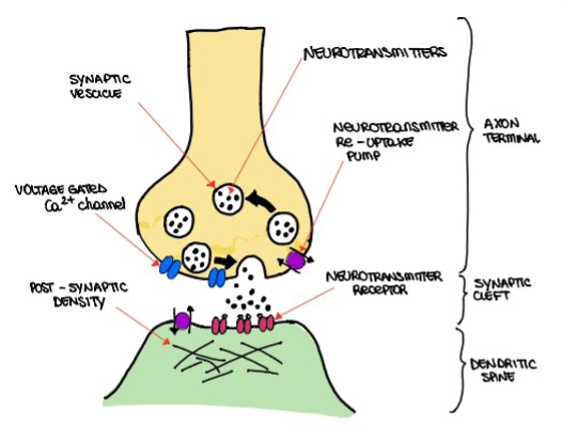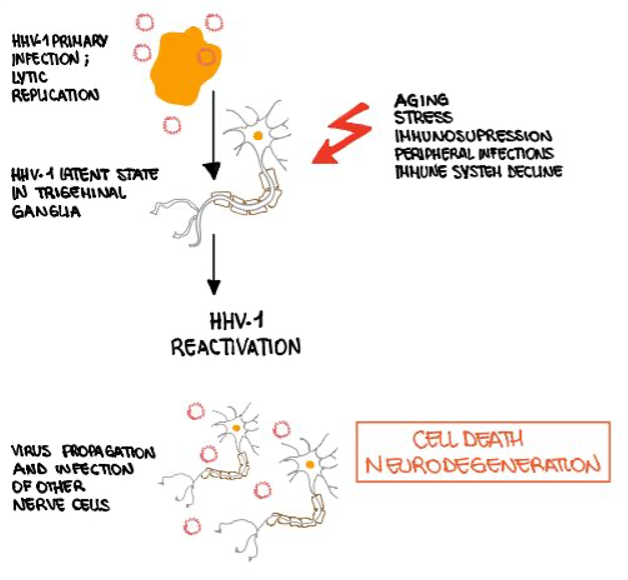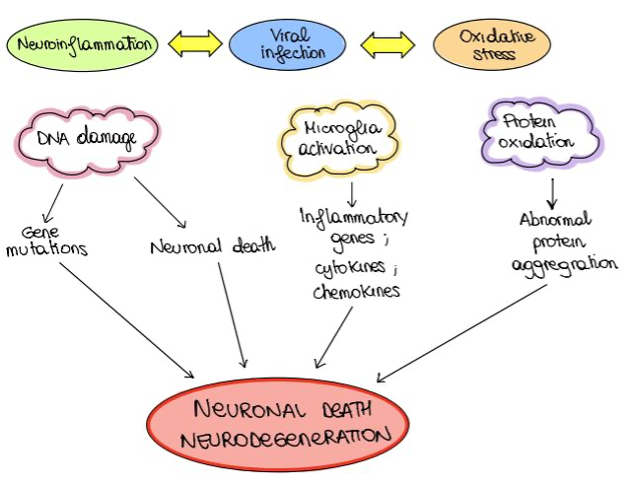|
Size: 21246
Comment:
|
Size: 21240
Comment:
|
| Deletions are marked like this. | Additions are marked like this. |
| Line 86: | Line 86: |
| <<Anchor(Bae and Kim, 2017)>> | <<Anchor(Bae and Kim)>> |
The role of herpesviruses in the development of Alzheimer's disease
Contents
- Introduction
- Correlation between herpesvirus and Alzheimer disease
- How can we protect ourselves from Alzheimer disease?
- References and external sources
- Other external sources
Introduction
In this essay, the correlation between the Herpes virus and Alzheimer disease is discussed. Alzheimer disease was first described by the German psychiatrist and neuropathologist, "Alois Alzheimer" in 1906. Since then, studies have been investigated the disease and its origin. Nowadays, it is known that intercellular depositions of amyloid β (Aβ) protein result in plaques, which can accumulate in the brain tissue disrupting the neural signaling and causing inflammation and damage the blood vessels within the brain (Minter et al, 2015). In addition, it was found that Tau protein, an intracellular component necessary for the stability of the neuron cytoskeleton and normal synaptic activity, can form neurofibrillary tangles which are another major cause of apoptosis of the neurons (Maltsev et al, 2013). All these altered processes leading to the degenerative processes seen in the brain of Alzheimer patients (Figure 1). Different researchers have been trying to find the underlying cause for the impaired processes. While certain study groups offered genetic background as a possible cause, nowadays an increasing interest in the correlation between the herpes virus and Alzheimer disease is taken into consideration. The current findings suggest two main types of herpes virus are the cause of the disease.
|
Figure 1 Brain scan of healthy brain VS. AD patient |
Correlation between herpesvirus and Alzheimer disease
Herpesvirus types associated with AD
Different studies have shown a connection between Alzheimer disease and certain types of herpes virus. The strongest connection was found between herpes simplex virus type 1 (HSV-1) in most of the cases investigated (Bourgade et al, 2014). Recent studies have shown that Human Herpes Virus type 6 (HHV-6) may be correlated with the disease as well (Readhead et al, 2018).
Physiological background
The basic functional unit of the nervous system is the neuron. Neurons are found within the central nervous system and in the periphery. The information between them is transferred from the presynaptic cleft to the postsynaptic cleft via chemicals named neurotransmitters. A stimulus reaches the neural membrane. If it reaches the threshold potential, an action potential is generated in the cell soma (body). Then it continues along the axon until it arrives at the axon terminal, in which neurotransmitters are stored in vesicles. Via exocytosis, the neurotransmitters are released from the presynaptic cleft to the synaptic cleft (the electrical signal is transferred to a chemical signal). The released neurotransmitters bind to receptors found on the postsynaptic dendritic spines and by corresponding processes involving other ions another AP is generated. Thus, the signal is transferred to the adjacent neurons (Bae and Kim, 2017). Representation of neural connection can be seen in (Figure 2).
Neurodegenerative diseases as Alzheimer disease alter the structures of the nerves and the connections between them, resulting in reduced numbers of vesicles and proteins that lead to degradation of the neurotransmitters and damages the Ca2+ regulation. [9]
|
Figure 2 Connection between neurons |
Pathophysiology
Mancuso et al, (2019) investigated brain sections of Alzheimer patients, in which traces of herpes virus types mentioned above were found. With evidence of accumulations associated with amyloid β plaques outside the cells and neurofibrillary tangles (Tau protein) inside the cells, which were correlated to Apolipoprotein (ApoE4).
HSV-1 and amyloid B (antimicrobial process)
Amyloid Precursor Protein (APP) is a protein integrated into the neurons' membrane. It is essential for the normal development of the cell, regulation of the presynaptic active zone (O'Brien and Wong, 2011), as well as the synaptic plasticity and cell adhesion (Mancuso et al, 2019). In a healthy brain, APP is used, degenerate, and recycled by beta and gamma-secretase enzymes, which cleave soluble parts of the protein. In AD patients with HSV-1, lower levels of APP and increased activity of gamma-secretase enzyme were found (Mancuso et al, 2019). These were associated with the cleavage of non-soluble fragments named Amyloid β, which aggregated and formed clusters, the amyloid β plaques. The plaques, which are first generated in the cortex (Oddo et al,2003), were shown to disrupt the neural signaling leading to the damages observed in the brains of AD patients [9].
HSV-1 and TAU proteins (deposition)
Tau protein is integrated into the microtubule system, which is a part of the neurons' cytoskeleton structure. It was found essential for the adequate transmission of information and normal neural activity and stability. Studies have shown that HSV-1 is correlated with hyperphosphorylation of Tau protein in the hippocampal region (Powell-Doherty et al, 2020). This is followed by a change in its structure and detachment from the microtubule system. The tau protein fragments then aggregate in paired helical filaments and form tangles inside the cell. This leads to the alternation in microtubules and cytoskeleton dynamics, which contribute to the dysfunction of neural communication activity and finally results in cell death (Harris and Harris, 2018).
Inflammation (suppression of immune system)
Sochocka et al (2017) correlated the neuroinflammatory responses to viral infections, particularly HSV-1 HSV-2, in AD patients (Figure 3). Following HSV-1 infection, increased activity of microglia and oligodendrocytes (glial cells which are associated with the immune defense of the CNS) was observed. In addition, it was suggested that the amyloid β plaques' appearance triggers the activation of anti-inflammatory processes and cytokines dysregulation which contributes to the progression of the disease. Moreover, the elderly population was found more susceptible to be infected by the virus due to suppressed immunity, contributing to higher permeability of the blood-brain barrier, which puts them at a higher risk to develop AD.
|
Figure 3 Schematic diagram – the effect of HS1 on neurons |
HSV-1 and oxidative stress
Oxidative stress (OS) occurs when there is an imbalance between antioxidants and free radicals within the cell. Limongi and Baldelli (2016) found that many viral infections, including HSV-1, induce oxidative stress associated with inflammation and neural degeneration (Figure 4). Oxidative stress correlated with HSV-1 was found to inhibit the secretion of amyloid β, resulting in the accumulation of amyloid β inside the cells. Moreover, OS and HHV-1 were suggested to impair the lysosomal activity within the cell, leading to the accumulation of lysosomal particles and finally cell degeneration (Kristen et al, 2018). Lastly, OS associated with HSV-1 was found to enhance mitochondrial damage, which can contribute to oxidative stress and neural degeneration (Harris and Harris, 2018). Thus, HSV-1 was proven to cause oxidative stress, which is suggested to increase the neurodegenerative processes linked to Alzheimer disease.
|
Figure 4 The relation between inflammation and oxidative stress |
HSV-1, HHV-6- and autophagy (autophagosome accumulation)
In healthy cells, autophagic activity is referred to the ability of the cell to induce intracellular immune activity. Autophagy is a process that involves several steps, in which the cell proteins are able to produce vesicles containing the detected viral particles. Via fusion of the virus-containing vesicles with cell lysosomes, the cell is capable of removing the harmful substances as well as misfolded and aggregated proteins and damaged organelles, which are nonfunctional cell particles. (Romeo et al, 2019). Orvedahl et al (2007) associated HSV-1 and HHV-6 with impaired autophagic activity in Alzheimer patients. In addition, Romeo et al (2019) stated that the viral protein ICP34.5 of HHV-1 was found to inhibit Beclin-1, a phagocytic protein associated with the regulation of the cell phagocytic activity. HHV-6 was also associated with damaged autophagic activity, however, its mechanism of action is still under research. The impaired autophagic activity results in neurodegenerative processes and cell death seen in AD patients. Herpes virus types that were linked to these neurodegenerative processes, were seen to contribute to these processes via the dysregulation of autosomes, accumulation of Amyloid β plaques, and intracellular fibrillary tangles (Orvedahl et al, 2007).
HSV-1 and apolipoprotein
ApoE is a gene responsible for the expression of apolipoproteins, which are glycoproteins necessary for the transport of different lipid molecules between tissues. ApoE has 3 isoforms (ApoE2, 3 and 4), which differ from each other in their nucleic acid sequence. AD patients with HSV-1 traces were associated with the ApoE4 allele, which is suggested to make them more vulnerable to HSV-1 infection. In order to enter the cell, HSV-1 binds to the HSPG membrane receptors. ApoE competes with HSV-1 for these binding sites, while ApoE4 was found to be less efficient than its other isoforms leading to the entrance of the virus particles and cell infection (Harris and Harris, 2015). Moreover, ApoE4 was correlated with neuroinflammation and proinflammatory factors, alternation in synaptic plasticity, lipid metabolism, cell signaling and increased permeability of the blood-brain barrier. All contribute to the progression of the disease (Harris and Harris, 2015).
Treatment (Future research) - Antiviral medication
Valacyclovir
Valacyclovir is the most widely used antiviral drug against HSV-1 and HSV-2, which can pass through the blood-brain barrier. As HSV-1 and HSV-2 were suggested to increase the susceptibility for Alzheimer, new trials suggest that the drug may be effective against the disease. Valacyclovir is the pro-drug of acyclovir which to found to inhibit the viral polymerase activity, leading to the death of the infected cells, but not healthy ones (Devanand, 2018). Further findings show the administration of valacyclovir and acyclovir reduces the accumulation of amyloid β extracellularly and decreases the phosphorylation of Tau protein (and subsequently the formation of the tangles) associated with AD disease. The Valacyclovir was approved by the FDA (Food and Drug Administration) as treatment in the therapy of AD patients (Harris and Harris, 2015).
VZV vaccine
VZV (Varicella-Zoster virus) vaccine is administered in the treatment of this High doses of the vaccine resulted in a decrease in the activity of the virus and strengthen the immune system (by increasing the antibody production) in elderly patients between 50-59 years (Qin and Li, 2019). Therefore, it was suggested that administration of VZV may lower the susceptibility to Alzheimer disease.
Can AD develop in the absence of HSV-1?
Different studies have shown that other risk factors are involved in the development of Alzheimer disease. Genetic background is one of the causes of allelic mutations on chromosome 1, 14 or 21, which were linked to amyloid β plaque formation. In addition, another mutation in the ApoE gene was found to contribute as well (Hoyer, 2000). Stress, depression and inadequate sleep were shown to affect the hypothalamic-pituitary-adrenal axis (HPA axis), leading to increased cortisol production that found to increase the amyloid β depositions in the hypothalamus and prefrontal cortex. Other studies linked the ApoE mutation with the appearance of the HPA axis and consequently the development of Alzheimer (Silvia et al, 2019). Smoking is another factor that may affect the development of Alzheimer disease. It is known that smoking generates the formation of free radicals, increases oxidative stress and promotes proinflammatory activity. In addition, it can lead to cerebrovascular diseases which increase the likelihood of the appearance of the disease (Silvia et al, 2019).
Stress, depression and inadequate sleep were shown to affect the hypothalamic-pituitary-adrenal axis (HPA axis), leading to increased cortisol production that found to increase the amyloid β depositions in the hypothalamus and prefrontal cortex. Other studies linked the ApoE mutation with the appearance of the HPA axis and consequently the development of Alzheimer (Silvia et al, 2019).
Smoking is another factor that may affect the development of Alzheimer disease. It is known that smoking generates the formation of free radicals, increases oxidative stress and promotes proinflammatory activity. In addition, it can lead to cerebrovascular diseases which increase the likelihood of the appearance of the disease (Silvia et al, 2019).
How can we protect ourselves from Alzheimer disease?
Unfortunately, no cure for Alzheimer disease has been found. However, there are recommended lifestyle behaviors, which may decrease the possibility to develop the disease. Physical activity was linked to decrease the risk for AD by 45% (Silvia et al, 2019). Reduced blood pressure, obesity and proinflammatory activity, better cerebral blood flow, more efficient oxygenation of the brain tissue, as well as the increase of IGF-1 (insulin-like growth factor), BDNF (brain-derived neuropathic factors), and VEGF (vascular endothelial growth factor) were found to induce synaptic plasticity and synthesis of neural factors. Mediterranean diet with its many beneficial health constituents such as unsaturated fat (found in olive oil or fish oil), antioxidants, vitamins E, C, B6 and B12. These were associated with decreased susceptibility to develop Alzheimer disease. In addition, vitamin D deficiency was correlated with an increase in the amyloid β depositions and a decrease in their degradation (Silvia et al, 2019).
References and external sources
- Bae JR, Kim SH (2017): Synapses in Neurodegenerative diseases. BMB Reports 50: (5) 237-246
- Bourgade K, Garneau H, Giroux G, Le Page AY, Bocti C, Dupuis G, Frost EH, Fülöp T Jr (2014): β-Amyloid peptides display protective activity against the human Alzheimer's disease-associated herpes simplex virus-1. Biogerontology 16: (1) 85-98
- Devanand DP (2018): Viral Hypothesis and Antiviral Treatment in Alzheimer's Disease. Current neurology and neuroscience reports 18: (9) 55
- Guo T, Zhang D, Yuzhe Z, Timothy YH, Huaxi X, Yingjun Z (2020): Molecular and cellular mechanism underlying the pathogenesis of Alzheimer’s disease. Molecular Neurodegeneration 15: (1) 40
- Harris SA, Harris EA (2015): Herpes Simplex Virus Type 1 and Other Pathogens are Key Causative Factors in Sporadic Alzheimer's Disease. Journal of Alzheimer’s Disease 48: (2) 319-353
- Harris SA, Harris EA (2018): Molecular Mechanisms for Herpes Simplex Virus Type 1 Pathogenesis in Alzheimer's Disease. Front Aging Neuroscience 10: 48
- Hoyer S (2000): Brain glucose and energy metabolism abnormalities in sporadic Alzheimer disease. Causes and consequences: an update. Experimental Gerontology 35: (9-10) 1363-1372
- Kristen H, Sastre I, Muñoz-Galdeano T, Recuero M, Aldudo J, Bullido MJ (2018): The lysosome system is severely impaired in a cellular model of neurodegeneration induced by HSV-1 and oxidative stress. Neurobiology of Aging 68: 5-17
- Limongi D, Baldelli S (2016): Redox Imbalance and Viral Infections in Neurodegenerative Diseases. Oxid Med Cell Longev. 2016: 6547248
- Maltsev AV, Dovidchenko NV, Uteshev VK, Sokolik VV, Shtang OM, Yakushin MA, Sokolova NM, Surin AK, Galzitskaya OV (2013): Intensive protein synthesis in neurons and phosphorylation of beta-amyloid precursor protein and tau-protein are triggering factors of neuronal amyloidosis and Alzheimer’s disease. Biochemistry (Moscow) Supplement Series B: Biochemical Chemistry 7: 278-293
- Mancuso R, Sicurella M, Agostini S, Marconi P, Clerici (2019): Herpes simplex virus type 1 and Alzheimer's disease: link and potential impact on treatment. Expert Review of Anti-infective Therapy 17: (9) 715-731
- Minter MR, Taylor JM, Crack PJ (2015): The contribution of neuroinflammation to amyloid toxicity in Alzheimer's disease. Journal of Neurochemistry 136: (3) 457-474
- O'Brien RJ, Wong PC (2011): Amyloid precursor protein processing and Alzheimer's disease. Annual review of neuroscience 34: 185-204
Oddo S, Caccamo A, Kitazawa M, Tseng BP, LaFerla FM (2003): Amyloid deposition precedes tangle formation in a triple transgenic model of Alzheimer's disease. Neurobiol Aging 24: (8) 1063-70
- Orvedahl A, Alexander D, Tallóczy Z, Sun Q, Wei Y, Zhang W, Burns D, Leib DA, Levine B (2007): HSV-1 ICP34.5 confers neurovirulence by targeting the Beclin 1 autophagy protein. Cell Host Microbe 1: (1) 23-35
- Powell-Doherty RD, Abbott ARN, Nelson LA, Bertke AS (2020): Amyloid-β and p-Tau Anti-Threat Response to Herpes Simplex Virus 1 Infection in Primary Adult Murine Hippocampal Neurons. Journal of virology 94: (9) e01874-19
- Qin Q, Li Y (2019): Herpesviral infections and antimicrobial protection for Alzheimer's disease: Implications for prevention and treatment. J Med Virol. 91: (8) 1368-1377
- Readhead B, Haure-Mirande JV, Funk CC, Richards MA, Shannon P, Haroutunian V, Sano M, Liang WS, Beckmann ND, Price ND, Reiman EM, Schadt EE, Ehrlich ME, Gandy S, Dudley JT (2018): Multiscale Analysis of Independent Alzheimer's Cohorts Finds Disruption of Molecular, Genetic, and Clinical Networks by Human Herpesvirus. Neuron 99: (1)64-82.
- Rizzo R (2020): Controversial role of herpesviruses in Alzheimer's disease. PLoS pathogens 16: (6) e1008575
- Romeo MA, Faggioni A, Cirone M (2019) Could autophagy dysregulation link neurotropic viruses to Alzheimer's disease? Neural Regen Research 14: (9) 1503-1506
- Santana S, Sastre I, Recuero M, Bullido MJ, Aldudo J (2013): Oxidative stress enhances neurodegeneration markers induced by herpes simplex virus type 1 infection in human neuroblastoma cells. PLoS One 8: (10) e75842
- Silva M, Loures C, Alves L, de Souza LC, Borges K, Carvalho M (2019): Alzheimer's disease: risk factors and potentially protective measures. Journal of biomedical science 26: (1) 33
- Sochocka M, Zwolińska K, Leszek J (2017): The Infectious Etiology of Alzheimer's Disease. Current neuropharmacology 15: (7) 996–1009




